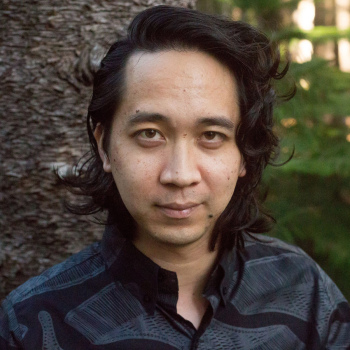
When I was young, I was afraid of the dark. I grew up with many superstitions in Hawaiʻi: don’t whistle at night or you’ll summon spirits, don’t take pork on the Pali Highway or bad things will happen. And so, around the age of eight, I trained myself to be brave, wanting to be like Link from The Legend of Zelda: Ocarina of Time. I forced myself to stand in the darkness, stare down any specters that may be around. It wasn’t until years later that I learned in Hawaiian culture, pō or darkness, was where life began, a place where ancestors live.
Sometimes when I engage with museum spaces, I feel like a time traveler, wandering in a dimly lit room, with a treasure map: seeing the artisan’s carving or brushstroke, or featherwork, it feels exciting to enter a different time. Sometimes it’s complicated. I visited the National Museum of the American Indian last year on Native American Heritage Day. The space and exhibits were beautiful, but also heavy. As I walked through the exhibit titled the Americans, I saw a troubled history of how the US has appropriated native imagery in branding, mascots, and more. I tried to stay, but left after only twenty minutes. I felt overwhelmed, pained: the parallels between how Native folx have been treated in Turtle Island and how Hawaiians have been treated in Hawai’i were hard to take in.
On the other hand, in the past few years I’ve been privileged to participate in projects with museums here at home, partnering with Capitol Modern (formerly known as the Hawaii State Art Museum) and the Shangri La Museum of Islamic Art, Culture & Design, and these experiences have been positive. A large part of it is how curators and museum workers allow access to space and items, and also how they communicate, contextualizing exhibits in their time period, but also pointing towards their significance in the present. Just the other day, I heard about a friend of a friend who was invited to help repatriate iwi kūpuna from a museum in Europe back to Hawai’i. They were so honored and overjoyed, as much as one can be joyful about bringing back ancestral remains to their ʻone hānau, their birth sands, their homeland.
Having these connections now, I feel embraced by ‘a sea of islands’ as Epeli Hauʻofa says, connected by our waterways. Being woven into this continuity of culture that permeates the Pacific gives me comfort.
When COVID came and the world turned upside down, my perspectives expanded, and opportunities came my way, like bottles washed ashore from other sands, including becoming acquainted with and working with Pasifika artists, many of whom have worked with museums. I feel I would be remiss not acknowledging my creative Pasifika elders and colleagues who have been instrumental in shaping me as a islander artist:
I learned about the groundbreaking legacy of Māori filmmaker Merata Mita while doing research for Stories of Oceania, a virtual theatre production for young audiences, devised by the company of Honolulu Theatre for Youth, led by the amazing theater artist, Moses Goods. While working on that project, I also had the honor of meeting Rotuman scholar-artist Dr. Vilsoni Hereniko, now known to me as Uncle Vili.
I developed as a writer with one of my writing heroes, Hawaiian journalist and playwright, Lee Cataluna, and have had the great pleasure of collaborating on many projects with her for the past few years, at home and in New York.
I had the opportunity to be mentored by Victoria Nalani Kneubuhl, another wahine Hawaiian playwright, and one of my favorite playwrights in the whole world.
I met my love, Kenji, who does not have a Oceanic background, but is a student at the Center for Pacific Island Studies at UH Mānoa. Through them, I was introduced to Mākua Valley, a land struggling for peace and demilitarization, I met colleagues from Saipan, Timor Leste, Rotuma, Rapa Nui, and beyond, and got to engage in conversations of what is happening in the Pacific, my oceanic backyard.
Sharing these connections is not about status or bragging, but about sharing a lineage of culture, a Moananuiākea Oceania culture that I wasn’t as aware of or I shamefully had no strong interest in as a child. Having these connections now, I feel embraced by ‘a sea of islands’ as Epeli Hauʻofa says, connected by our waterways. Being woven into this continuity of culture that permeates the Pacific gives me comfort.
In the murkiness of this wild world, I hope for reconciliation and regeneration, led by the light of the kukui nut torch, the lamaku, that I hold out hoping that maybe I will help someone else not be afraid of the dark.
And I can imagine, in the pō, lit by starlight, the starlight that the elves I love from Tolkien’s Middle Earth were born under, the starlight that led my navigator ancestors on their journeys across the ocean, the starlight that illuminates community from lands near and far, past and present, that the families of Oceania gather, guided by moon phases, preparing for celebrations of every kind. In the murkiness of this wild world, I hope for reconciliation and regeneration, led by the light of the kukui nut torch, the lamaku, that I hold out hoping that maybe I will help someone else not be afraid of the dark.
